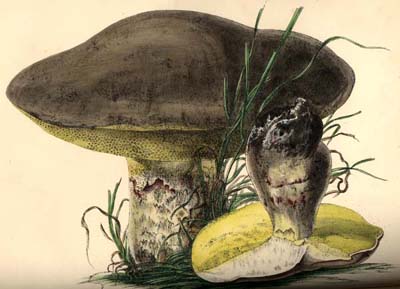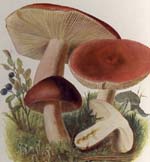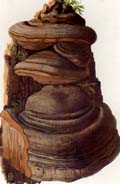 If your mushroom is normal mushroom-shaped, but has a layer of tubes on the bottom of the cap instead, it is a Bolete and will also be included later. For right now, we're just concentrating on the gilled mushrooms and polypores .
If your mushroom is normal mushroom-shaped, but has a layer of tubes on the bottom of the cap instead, it is a Bolete and will also be included later. For right now, we're just concentrating on the gilled mushrooms and polypores .
A key is kind of like a flow chart: at each step you are presented with choices, and each choice takes you to a new place in the key. As you make more choices, you get closer and closer to identifying your mushroom. Until you get to an actual species, each node in the key has a lower part that says "Narrow down your identification:". These choices help you narrow your search.
As you move through the key, each page also displays the previous choices that brought you to that point. When you arrive at a page, you move to the part of that page featuring your current choice, in large type. But above it are all the previous choices that got you to that point, in smaller type. This serves two purposes: first of all, the previous choices you have made help describe your mushroom. Although each choice you make only describes one or two features of the mushroom, when you put them together, they add up to a pretty complete description. This website doesn't feature a suddenly detailed description when you reach a species; instead, the stack of features you have already chosen constitutes a description.
The other purpose served by having each page display a stack of previous choices is that it makes backtracking simpler. If you have ever used a key before, you know that sometimes it takes you to places that have nothing to do with the mushroom you're trying to identify. That won't happen with this key, of course! but if it does, you have an easy way to backtrack and see where you went wrong. And of course, it also makes it easier to navigate the key, check on related species, and so on. Each node in the key is also named, and this should likewise make it easier to keep track of where you are than in a traditional key.
Another feature of the key is look-alikes. Some mushrooms have features that make them reachable through several different paths in the key. Such mushrooms are listed through one "natural path" and through the others as look-alikes. Look-alikes are listed at the very bottom of the "Refine your identification" section, with a lighter background color. Nodes in the key that are reachable as a look-alike display that look-alike in the stack above the main entry for that page, but they do so off to the right, with the same lighter background color. That way you can backtrack to the look-alikes easily, but you don't have to read their characters as part of the description of your mushroom.
The key assumes several default conditions for mushrooms: unless specified differently, all gills are assumed to be attached; all gills and stems are assumed to be white; the taste of all mushrooms are assumed to be mild, and their caps are assumed to be smooth. Likewise, spores are assumed to be as rounded as possible, and smooth. I have selected only species that are known to occur or might reasonably occur in the Great Lakes area.
That's all there is to it!
If you already know the name of the taxon that you're looking for, you can search for it more quickly in the index to genera,
the index to species by genus
or the index to species by epithet
If you have any corrections or comments please send them to me.

 Gilled Mushrooms: Agaricales Subphylum
Gilled Mushrooms: Agaricales Subphylum Gilled Mushrooms: Russulales Subphylum
Gilled Mushrooms: Russulales Subphylum Polypores Subphylum
Polypores Subphylum



